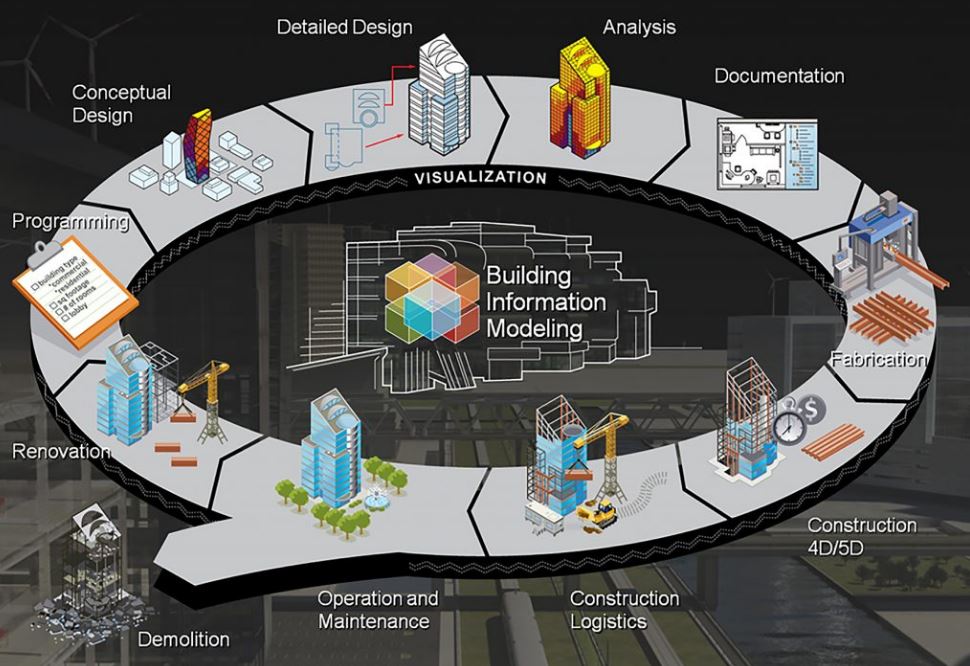Effective Methods of Integrating Building Information Modelling (BIM) into Design and Build (2014)
Integrating Building Information Modelling into Design and Build Dissertation – Current methods for the procurement of built assets have been condemned for not delivering the solutions that the client desires. design and build procurement is a commonly used procurement approach that typically gives the contractor leading control over design and construction. Building Information Modelling, an emerging collaborative technology, brings greater efficiencies to design and build because designers are drawn closer together in collaborating to create a BIM model.
The aim of this dissertation is to determine the most efficient approach to integrating BIM into design and build. Primary and secondary research was carried out to gain an expansive range of views on the most efficient solutions coming from both academia and the construction industry. The primary research was qualitative in nature with the semi-structured interviewing research technique being employed to gather data.
Key themes that were discovered were that the construction industry has a lack of understanding of contracts and BIM. There is no consensus on whether contracts need to be changed if BIM is to be implemented. In spite of this finding, it was found that the greatest efficiencies can be had when BIM is integrated into the Develop & Construct variation of design and build, with the novation of the client’s design team and a linear programme of design and construction.
Research into the field of BIM has flourished in recent years. A great deal of this BIM literature considers the potential that BIM has on construction projects and why it has not yet been widely adopted in industry. There is, however, very little information relating to the practicalities of integrating BIM into the design and construction processes and BIM’s interaction with different procurement routes. BIM policy is shaped by research and the policy aim is to prepare the industry for the coming of BIM, acknowledging the possible benefits, risks and conflicts.
The Government preferred a contractor led project to model BIM because the belief was that implementation would be easier. Contacts are fundamental to construction and this is highlighted by the contractor and subcontractor roles being named after this tool. Design and build procurement route is a favoured approach in the UK right now and is to be examined in this research. Companies need to understand the benefits that BIM can bring and a ‘BIM business case’ has appeal to the top management. However this needs to be supported by a method for implementation. Other researchers have attempted to discover the most practical method of Building Information Modelling implementation.
Commenting that previous efforts fail to fully address the effectiveness of BIM once implemented generated a framework which tackles BIM issues. This dissertation goes on to assess how to maximise the performance of BIM when using the design and build procurement route. A discussion with a Director of Research and Development confirmed that the study would add value to the industry and create a better insight into the area of BIM.
The aim of the dissertation is to determine the most efficient approach to integrating BIM into construction project procured through design and build route. Dissertation objectives;
- To understand the type of Contract Documents that bidders are currently providing under design and build Contracts and determining how a BIM model could contribute
- To assess whether a BIM model would be a valuable addition for a design and build project
- To investigate the challenges of integrating BIM into design and build projects
- To investigate how a BIM model could be developed in the post tender stage in design and build projects
- To determine the most efficient approach to integrating BIM
- 11,000 words – 52 pages in length
- Excellent use of literature
- Good analysis of subject area
- Well written throughout
- Ideal for quantity surveying students
1 – Introduction
Background
The Common Procurement Approaches
Dissertation Rationale
Aim and Objectives
Chapter Summary
Research Framework
2 – Literature Review
Defining BIM
design and build Contract Documents
What BIM contributes to design and build
BIM Maturity
The Challenges of integrating BIM into design and build
BIM model development Post-tender with design and build
Key Literature Findings
3 – Research Methodology
Research Philosophy
Research method
Research Approach / Technique
The Sample
Research Ethics
Empirical Design
4 – Critical Analysis
Coding Results
The type of benefits that the addition of BIM to design and build could bring
The Challenges of integrating BIM into design and build
Development of the BIM model Post-tender with design and build
5 – Conclusions and Limitations
Conclusions
Limitations
Further Research
References
Appendix
Sample Interview Transcript

